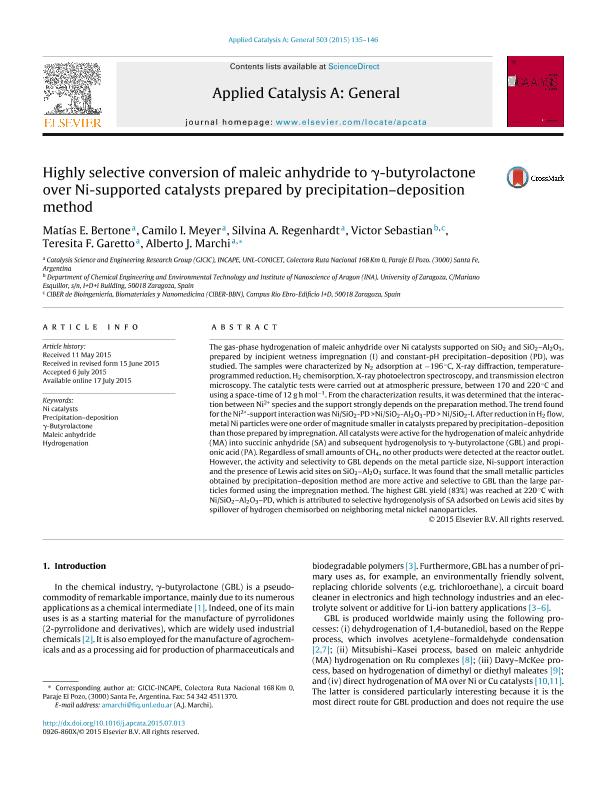Mostrar el registro sencillo del ítem
dc.contributor.author
Bertone, Matías Ezequiel

dc.contributor.author
Meyer, Camilo Ignacio

dc.contributor.author
Regenhardt, Silvina Andrea

dc.contributor.author
Sebastian, Victor
dc.contributor.author
Garetto, Teresita Francisca

dc.contributor.author
Marchi, Alberto Julio

dc.date.available
2020-09-14T12:40:44Z
dc.date.issued
2015-07
dc.identifier.citation
Bertone, Matías Ezequiel; Meyer, Camilo Ignacio; Regenhardt, Silvina Andrea; Sebastian, Victor; Garetto, Teresita Francisca; et al.; Highly selective conversion of maleic anhydride to gamma-butyrolactone over Ni-supported catalysts prepared by precipitation-deposition method; Elsevier Science; Applied Catalysis A: General; 503; 7-2015; 135-146
dc.identifier.issn
0926-860X
dc.identifier.uri
http://hdl.handle.net/11336/113876
dc.description.abstract
The gas-phase hydrogenation of maleic anhydride over Ni catalysts supported on SiO2 and SiO2-Al2O3, prepared by incipient wetness impregnation (I) and constant-pH precipitationdeposition (PD), was studied. The samples were characterized by N2 adsorption at -196 ºC, Xray diffraction, temperature-programmed reduction, H2 chemisorption, X-ray photoelectron spectroscopy and transmission electron microscopy. The catalytic tests were carried out at atmospheric pressure, between 170 and 220ºC and using a space-time of 12 g·h·mol-1. From the characterization results, it was determined that the interaction between Ni2+ species and the support strongly depends on the preparation method. The trend found for the Ni2+ -support interaction was Ni/SiO2-PD >Ni/SiO2-Al2O3-PD > Ni/SiO2-I. After reduction in H2 flow, metalNi particles were one order of magnitude smaller in catalysts prepared by precipitationdeposition than those prepared by impregnation. All catalysts were active for the hydrogenation of maleic anhydride (MA) into succinic anhydride (SA) and subsequent hydrogenolysis to GAMMA-butyrolactone (GBL) and propionic acid (PA). Regardless of small amounts of CH4, no other products were detected at the reactor outlet. However, the activity and selectivity to GBL depends on the metal particle size, Ni-support interaction and the presence of Lewis acid site on SiO2-Al2O3 surface. It was found that the small metallic particles obtained by precipitationdeposition method are more active and selective to GBL than the large particles formed using the impregnation method. The highest GBL yield (83%) was reached at 220 ºC with Ni/SiO2- Al2O3-PD, which is attributed to selective hydrogenolysis of SA adsorbed on Lewis acid sites by spillover of hydrogen chemisorbed on neighboring metal nickel nanoparticles.
dc.format
application/pdf
dc.language.iso
eng
dc.publisher
Elsevier Science

dc.rights
info:eu-repo/semantics/openAccess
dc.rights.uri
https://creativecommons.org/licenses/by-nc-sa/2.5/ar/
dc.subject
NI CATALYSTS
dc.subject
PRECIPITATION-DEPOSITION
dc.subject
G-BUTYROLACTONE
dc.subject
MALEIC ANHYDRIDE
dc.subject
HYDROGENATION
dc.subject.classification
Otras Ingeniería Química

dc.subject.classification
Ingeniería Química

dc.subject.classification
INGENIERÍAS Y TECNOLOGÍAS

dc.subject.classification
Nano-materiales

dc.subject.classification
Nanotecnología

dc.subject.classification
INGENIERÍAS Y TECNOLOGÍAS

dc.subject.classification
Química Inorgánica y Nuclear

dc.subject.classification
Ciencias Químicas

dc.subject.classification
CIENCIAS NATURALES Y EXACTAS

dc.title
Highly selective conversion of maleic anhydride to gamma-butyrolactone over Ni-supported catalysts prepared by precipitation-deposition method
dc.type
info:eu-repo/semantics/article
dc.type
info:ar-repo/semantics/artículo
dc.type
info:eu-repo/semantics/publishedVersion
dc.date.updated
2020-09-03T19:19:38Z
dc.journal.volume
503
dc.journal.pagination
135-146
dc.journal.pais
Países Bajos

dc.journal.ciudad
Amsterdam
dc.description.fil
Fil: Bertone, Matías Ezequiel. Consejo Nacional de Investigaciones Científicas y Técnicas. Centro Científico Tecnológico Conicet - Santa Fe. Instituto de Investigaciones en Catálisis y Petroquímica "Ing. José Miguel Parera". Universidad Nacional del Litoral. Instituto de Investigaciones en Catálisis y Petroquímica "Ing. José Miguel Parera"; Argentina
dc.description.fil
Fil: Meyer, Camilo Ignacio. Consejo Nacional de Investigaciones Científicas y Técnicas. Centro Científico Tecnológico Conicet - Santa Fe. Instituto de Investigaciones en Catálisis y Petroquímica "Ing. José Miguel Parera". Universidad Nacional del Litoral. Instituto de Investigaciones en Catálisis y Petroquímica "Ing. José Miguel Parera"; Argentina
dc.description.fil
Fil: Regenhardt, Silvina Andrea. Consejo Nacional de Investigaciones Científicas y Técnicas. Centro Científico Tecnológico Conicet - Santa Fe. Instituto de Investigaciones en Catálisis y Petroquímica "Ing. José Miguel Parera". Universidad Nacional del Litoral. Instituto de Investigaciones en Catálisis y Petroquímica "Ing. José Miguel Parera"; Argentina
dc.description.fil
Fil: Sebastian, Victor. Universidad de Zaragoza; España
dc.description.fil
Fil: Garetto, Teresita Francisca. Consejo Nacional de Investigaciones Científicas y Técnicas. Centro Científico Tecnológico Conicet - Santa Fe. Instituto de Investigaciones en Catálisis y Petroquímica "Ing. José Miguel Parera". Universidad Nacional del Litoral. Instituto de Investigaciones en Catálisis y Petroquímica "Ing. José Miguel Parera"; Argentina
dc.description.fil
Fil: Marchi, Alberto Julio. Consejo Nacional de Investigaciones Científicas y Técnicas. Centro Científico Tecnológico Conicet - Santa Fe. Instituto de Investigaciones en Catálisis y Petroquímica "Ing. José Miguel Parera". Universidad Nacional del Litoral. Instituto de Investigaciones en Catálisis y Petroquímica "Ing. José Miguel Parera"; Argentina
dc.journal.title
Applied Catalysis A: General

dc.relation.alternativeid
info:eu-repo/semantics/altIdentifier/doi/http://dx.doi.org/10.1016/j.apcata.2015.07.013
Archivos asociados
